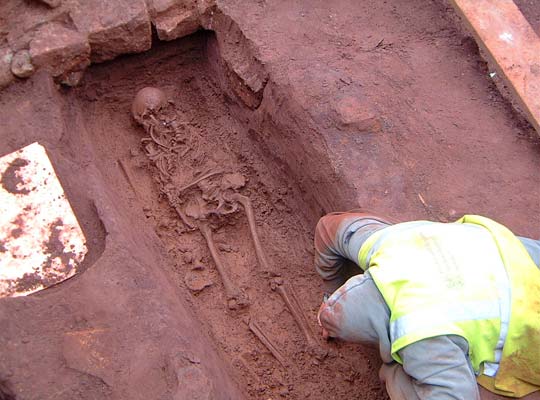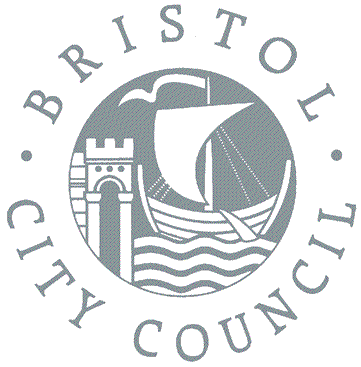St James’ Priory, Part 2
The redevelopment of Bristol’s Bus Station gave an opportunity to look 900 years into the past and uncover the story of Bristol’s first priory.

Excavation of a skeleton during the 2004 excavations at St James’s
St James’s Priory was the earliest monastic settlement in central Bristol, founded as a Benedictine house in about 1129 as a daughter of Tewkesbury Abbey. Its founder was Henry I’s illegitimate son, Robert, the future Earl of Gloucester. Robert was amongst the most influential men in the kingdom, and began building the Priory in 1129, when Bristol castle was under construction.
Although few sources describe the original layout of the priory, it is clear that it was unusual: the cloister lay to the north due to the site making the more normal south cloister impractical.
In 1534, Henry VIII declared himself the Supreme Head of the Church in England. The Catholic monastic way of life was gradually suppressed, and the number of monks at St James’s Priory dwindled: by 1535, it was occupied by just five brothers, and a year later there were just two. In 1539, the Abbot of Tewkesbury—perhaps anticipating the complete dissolution of his abbey and the closure of St James’s—leased the priory and its lands. By the early 1540s, parts of the church had fallen into ruin.
In 1544, Henry Brayne, a wealthy merchant tailor from London, converted the priory into a mansion house with a great hall and long gallery. The next major development on the site was in 1667, when Thomas Ellis established a sugarhouse for refining sugar imported from the Caribbean. Over the next two centuries, the land to the north of the church became increasingly developed. In 1877 the Bristol Tramway stables occupied much of the site, to be replaced by the bus station in 1958. Despite this intense development, elements of the 12th-century priory still survive: the original west end of the church is still standing, next to the White Hart Inn.
In November 2004, Bristol and Region Archaeological Services began excavating the priory site before Mowlem started constructing a new bus station.

Cloister arch base found during 2004
We had ten weeks to uncover as much evidence as we could. From early on it was clear that all the later building had disturbed the medieval remains. Even so, we were able to identify some of the walls of the cloisters.

12th-13th century cooking pot found during the 2004 excavation of St James’s
We found medieval rubbish pits with lots of pottery—in one of them, an almost complete jug. We also found cellars that may have been part of either Brayne’s mansion or Ellis’s sugarhouse. Stone from the original Priory had been reused: in a later stone drain running across the site, we found one stone with a carved head and others engraved with crosses.

Row of graves found beneath the cloister walkway during 2004

Skeleton from the 1995 St James’s Priory excavation
There are often burials under cloisters, so we expected to find some. In the end, 25 burials emerged from the ground under what had been the passenger concourse at Bristol’s Bus Station. Most of them were coffin burials: the outline remained, as well as iron coffin nails. Some of them were shroud burials, fitted neatly into holes cut into the bedrock. The skeletons will be analysed at the University of Bristol to find out more about the medieval people who lived and died in Bristol, then they’ll be reburied in a Christian cemetery.
On a particularly rainy Saturday in January 2005, over 2000 people came to our Open Day and queued patiently to see what was being discovered under the Bus Station. We hope that as well as documenting the history of Bristol that we also helped to connect people to over 800 years of Bristol’s history.
- Categories
- Events
Excavations
Finds
Survey
BaRAS is registered as an organisation with the Chartered Institute for Archaeologists
All material © copyright BaRAS 2004 – 2016




